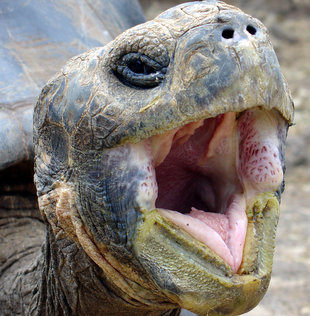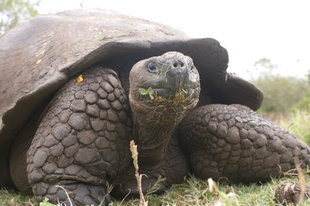Name: Galapagos Tortoise (Geochelone elephantopus)
Length: up to 150 cm over the curve of the carapace
Weight: up to 250 kg
Introduction
Giant tortoises are unmistakable by their large size and distinctive shape. Generally, the Galapagos tortoise exhibits two distinctive carapace shapes: dome-shelled and saddle-backed, although intermediate forms do occur. The dome-shaped subspecies tends to have a shorter head and neck than the saddle-back variety. The front edge of the saddle-backs' carapace is raised, which enables maximum elevation of their long necks, while it narrows at the rear end. The carapace shape of subspecies becki is very variable, with some individuals being dome shaped, others flattened, while the remainder are saddle-back shaped.
Identification
Giant tortoises are unmistakable by their large size and distinctive shape. Generally, the Galapagos tortoise exhibits two distinctive carapace shapes: dome-shelled and saddle-backed, although intermediate forms do occur. The dome-shaped subspecies tends to have a shorter head and neck than the saddle-back variety. The front edge of the saddle-backs' carapace is raised, which enables maximum elevation of their long necks, while it narrows at the rear end. The carapace shape of the intermidiates are very variable, with some individuals being dome shaped, others flattened, while the remainder are saddle-back shaped.
Both sexes of all the subspecies are alike, although males are considerably larger than females, have a concave ventral plate (plastron) and significantly larger tail. Overall weights and sizes vary depending on the subspecies.
Voice
On the whole giant tortoises remain silent; however, males emit a loud deep groaning sound during copulation, which can often be heard over a considerable distance. This often combines with a regular knocking sound and the male's shell collides with the female.
Behaviour
Giant tortoises are generally up and about between the hours of 08:00 and 16:00. There is no specific breeding season, with mating occurring almost every month of the year. However, the peak mating time is generally during the warm / wet season, with eggs usually hatching between December and April. Giant tortoises will normally reach sexual maturity between the ages of 20 and 25 years. During the breeding season, the male will become very territorial and will chase other males around with their heads raised. The dominant male is generally determined as being the one that raises its neck the highest.
Galapagos Tortoises








